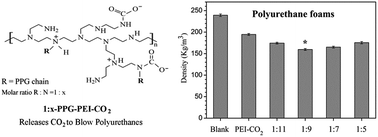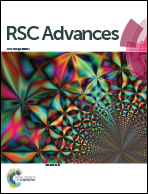A family of polypropylene glycol-grafted polyethyleneimines reversibly absorb and release carbon dioxide to blow polyurethanes†
Abstract
The polyurethane foam community has encountered increasing pressure to replace the ozone depleting and/or global warming blowing agents, such as chlorofluorocarbons (CFCs) and hydrochlorofluorocarbons (HCFCs). In this study, a series of polypropylene glycol-grafted polyethyleneimines (PPG-PEIs) were synthesised with the grafting rate ranging from 9% to 19%. Their CO2 adducts (PPG-PEI–CO2s) are thermally instable and can release CO2 to blow polyurethanes, whose polymerisation is exothermic. A PPG grafting rate of about 11% (found in sample 1 : 9-PPG-PEI–CO2) is enough to homogenously disperse the blowing agent into polyurethane raw materials. The CO2 adducts with a PPG grafting rate of about 11–14% are particularly effective to decrease the foam density. The foams blown by 1 : 9-PPG-PEI–CO2 possess a thermal conductivity higher than those of traditional polyurethane foams (0.040 vs. 0.020–0.027 W m−1 K−1), hindering their application in thermal insulation. However, these new blowing agents are advantageous in zero emission of volatile organic compounds (VOCs), as well as their climate friendliness. We believe these blowing agents can be used in thermally insulating foams in cars and aircraft where VOCs are strictly regulated.


 Please wait while we load your content...
Please wait while we load your content...